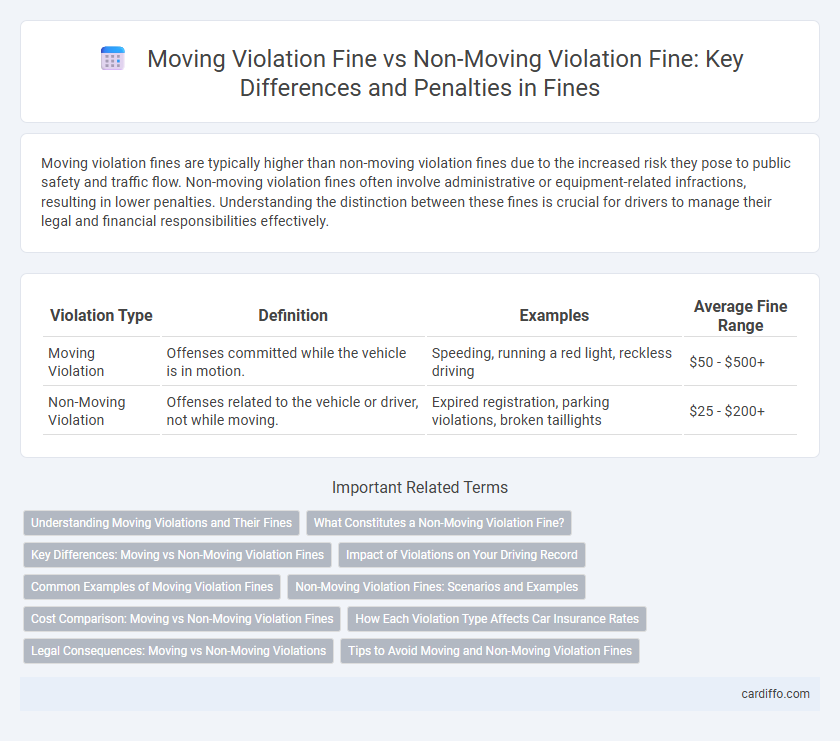Moving violation fines are typically higher than non-moving violation fines due to the increased risk they pose to public safety and traffic flow. Non-moving violation fines often involve administrative or equipment-related infractions, resulting in lower penalties. Understanding the distinction between these fines is crucial for drivers to manage their legal and financial responsibilities effectively.
Table of Comparison
| Violation Type | Definition | Examples | Average Fine Range |
|---|---|---|---|
| Moving Violation | Offenses committed while the vehicle is in motion. | Speeding, running a red light, reckless driving | $50 - $500+ |
| Non-Moving Violation | Offenses related to the vehicle or driver, not while moving. | Expired registration, parking violations, broken taillights | $25 - $200+ |
Understanding Moving Violations and Their Fines
Moving violations include offenses such as speeding, running red lights, and reckless driving, which directly impact safety and carry higher fines and point penalties on driving records. Non-moving violations typically involve vehicle maintenance issues or documentation lapses, like expired registration or broken taillights, resulting in lower fines without affecting the driver's license points. Understanding these distinctions helps drivers anticipate the financial and legal consequences associated with different types of traffic infractions.
What Constitutes a Non-Moving Violation Fine?
A non-moving violation fine is imposed for offenses that do not involve the actual movement of a vehicle, such as parking violations, expired registration, or equipment infractions like broken taillights. These fines differ from moving violation fines, which are related to unsafe driving behaviors including speeding, running red lights, or reckless driving. Typically, non-moving violation fines are lower and do not affect the driver's license points or insurance premiums.
Key Differences: Moving vs Non-Moving Violation Fines
Moving violation fines are typically higher than non-moving violation fines due to the increased risk they pose to road safety. Moving violations, such as speeding or running a red light, directly impact vehicle operation and often result in points on the driver's license, affecting insurance rates. Non-moving violations, including expired registration or parking infractions, usually incur smaller fines and do not result in license points, reflecting their lesser impact on traffic safety.
Impact of Violations on Your Driving Record
Moving violation fines typically result in points being added to your driving record, increasing insurance premiums and risking license suspension. Non-moving violation fines, such as parking tickets, generally do not affect your driving record or insurance rates but still require timely payment to avoid late fees. Accumulating moving violations can significantly impact your driving privileges and financial liabilities.
Common Examples of Moving Violation Fines
Common examples of moving violation fines include speeding tickets, running red lights, and illegal lane changes, with penalties varying based on speed excess and state regulations. Fines for moving violations often range from $50 to over $500, and repeated offenses can lead to increased penalties or license suspension. Unlike non-moving violations, such as parking infractions, moving violation fines impact driving records and insurance premiums significantly.
Non-Moving Violation Fines: Scenarios and Examples
Non-moving violation fines typically arise from infractions such as expired vehicle registration, parking violations, or equipment defects like broken taillights. These fines are often less severe than moving violation fines and usually do not affect driving records or insurance premiums. Examples include parking tickets, failure to display a valid inspection sticker, and violations related to vehicle maintenance issues.
Cost Comparison: Moving vs Non-Moving Violation Fines
Moving violation fines typically range from $100 to $500 depending on the severity and jurisdiction, often increasing with offenses like speeding or reckless driving. Non-moving violation fines, including parking or equipment violations, generally cost between $25 and $150, reflecting their lower impact on traffic safety. The cost disparity highlights the greater financial consequences associated with moving violations due to their direct risk to public safety.
How Each Violation Type Affects Car Insurance Rates
Moving violation fines typically lead to significant increases in car insurance rates due to the perceived higher risk of accidents and traffic violations. Non-moving violation fines, such as parking tickets, generally have little to no impact on insurance premiums since they do not reflect driver behavior affecting road safety. Insurance companies prioritize moving violations when determining rates because they indicate the driver's likelihood of filing future claims.
Legal Consequences: Moving vs Non-Moving Violations
Moving violation fines often result in more severe legal consequences, including points on the driver's license, increased insurance premiums, and potential license suspension. Non-moving violation fines typically involve penalties related to vehicle equipment, registration, or parking infractions, which rarely affect driving privileges or insurance rates. Courts prioritize moving violations due to their direct impact on road safety and driver behavior regulation.
Tips to Avoid Moving and Non-Moving Violation Fines
To avoid moving violation fines, always adhere to speed limits, use turn signals, and obey traffic signals to ensure compliance with road safety laws. For non-moving violation fines, maintain up-to-date registration, display valid parking permits, and pay attention to parking signs and restrictions. Regularly reviewing local traffic regulations and using reminders for renewals or vehicle inspections can significantly reduce the risk of both moving and non-moving violation penalties.
Moving violation fine vs non-moving violation fine Infographic

 cardiffo.com
cardiffo.com